How to Fix Squeaky Hardwood Floors
March 19, 2024 | By Bruce Product Expert
It’s pretty standard for hardwoods to develop creaks. For some, those creaking sounds are part of the charm of solid wood flooring. For others, they’re a substantial annoyance, and they wish they’d go away.
Fortunately, you can fix squeaky wood floors if you’re so inclined.
Types of Squeaky Wood Floors
Squeaks in wood floors fall into three main types: board-to-board, board-to-edge, and edge-to-edge.
Board-to-board squeaks occur when two adjacent floorboards rub against each other. This is the most common type of squeak, usually caused by uneven flooring or a lack of proper sealing.
Board-to-edge squeaks happen when a floorboard moves against the edge of the room, often from a warped floorboard or uneven sealing.
Edge-to-edge squeaks are less common. They relate to the expansion and contraction of the wood over time. They can also stem from a gap between the subfloor and the edge of the room.
To prevent squeaky wood floors, it’s crucial to address the underlying causes that lead to these noises.
5 Common Causes of Squeaky Floors
Let’s start by getting to the root of things and what causes squeaks and creaks in the first place.
Squeaky floors happen because of various factors relating to movement within the floor structure. And that’s true regardless of wood species or whether you install solid or engineered hardwood flooring.
Here’s a detailed breakdown of the common causes:
1. Seasonal Fluctuations
Wood expands and contracts with temperature changes. During dry winters, the floor contracts, creating space between the floorboards and the subfloor, leading to squeaks as the wood adjusts.
This issue typically resolves itself as the temperature and humidity rise again, allowing the floor to expand. That tightens any gaps and stops the squeaks.
2. Subfloor Problems
An uneven or misaligned subfloor can create gaps between the subfloor and the top floor. It can also create gaps between the subfloor and the joists. This movement allows the top floor to shift, causing squeaks.
An old or water-damaged subfloor may also not correctly hold nails and other fasteners. That leads to a loose top floor that can shift and squeak.
3. Floorboard Movement
Squeaks can also occur when hardwood planks themselves move. This can stem from insufficient fasteners, causing the boards to rub against each other.
4. Loose Hardware
The loosening of hardware, such as nails or screws that holds the floor in place, can lead to squeaks. As the hardware no longer fits tightly, the floorboards can rub together, producing noise.
Similarly, improper nailing of the floorboards to the subfloor can contribute to squeaks. If you don’t drive the nails deep enough, they can move and cause the floorboards to rub against each other.
5. Bridging Between Joists
Sometimes, the bridging between joists flexes under traffic. That’s particularly true in areas of the floor with a lot of foot traffic, like hallways or family rooms.
Now that you know what causes the squeaks, let’s get down to how to eliminate them from your solid hardwood flooring.
7 Ways to Fix Creaky Wood Floors
Addressing squeaky wood floors involves employing various methods tailored to the specific causes of the squeaks. Some are as simple as applying some lubricant. Others include driving some screws into loose planks.
The good news is that stopping most creaks involves simple DIY solutions. However, a flooring expert may be necessary for more complex problems.
You can start by listening for the squeak type to determine whether it’s a board-to-board, board-to-edge, or edge-to-edge squeak. Using a flashlight or a handheld mirror can help you visually inspect the floors for signs of unevenness or gaps.
But here are some of the typical solutions for eliminating squeaky floors.
1. Secure Loose Floorboards
Start by locating the squeaky areas and driving screws through the floorboards into the underlying joists. Make sure to choose the appropriate type and size of screws for optimal results. You can also apply a bead of wood glue to the edge of the floorboard to prevent it from moving against the edge of the room.
2. Sand Rough Surfaces
Sometimes, the floor’s surface can be uneven and create creaks. When installing hardwood flooring, for example, you might incur roughness and graininess after refinishing. Use a sanding block to smooth out any rough spots causing squeaks.
3. Apply Lubricants or Powdered Graphite
Lubricants or powdered graphite can reduce friction between floorboards, thereby silencing squeaks. To apply the lubricant, locate the squeaky joint and apply the powder to the crack between the boards. Lightly brush the powder back and forth until it settles in the crack. This process can help stop the squeak, at least temporarily, by reducing the friction that causes the noise.
4. Install Shims to Eliminate Gaps
To eliminate gaps, use shims between the subfloor and joists. That helps to stabilize the floor and reduce movement.
5. Replace Damaged Floorboards
You may need to remove and replace damaged planks.
6. Add a Skirt
Install a skirt to create a barrier between the floorboard and the edge of the room. Sometimes, a gap between the two can cause rubbing and squeaks.
7. Plug in a Humidifier
Another measure is to increase the humidity in the room with the squeaky floors. Many floors squeak when the air becomes too dry, as the wood shrinks and opens gaps between boards and around fasteners. Placing a humidifier in the room can help maintain a more consistent humidity level, reducing the likelihood of squeaks.
Tips for Preventing Squeaky Floors
The best way to fix squeaky floors is by heading things off at the pass!
First, maintain consistent humidity levels within your home. That helps minimize the expansion and contraction of wood. And that substantially reduces the likelihood of squeaks developing over time.
Second, pay close attention to the initial installation. Proper installation of subflooring and floorboards during construction or renovation projects can prevent future issues. Ensure installers deeply drive nails into planks and add glue to create a firm bond with the joists. Ensure all fasteners are secure to prevent your floors from lifting.
Third, acclimate your hardwood before installing it. That helps prevent gaps or tight spots from initial contraction or expansion before installation.
Fourth, check for loose or damaged floorboards regularly to prevent squeaks from happening in the future.
Finally, use rugs or mats in high-traffic areas to minimize wear and tear on your wood floors. You can also place furniture pads beneath heavy furniture. Both help preserve your floor’s integrity and stop it from barking at you.
America Was Built on Bruce® Flooring
Quality hardwood flooring makes all the difference, even with preventing squeaky floors. And Bruce® has been delivering that quality to homes for 140 years.
We make most of our wood flooring products in the USA. The lumber comes from trees sourced locally, mainly in the Appalachian area of the country.
Count on Bruce for a great selection of hardwoods in different styles and colors — over 350. Use our store locator to find a dealer nearest you.

Ready to shop for hickory flooring near you?
Use our retail locator to find where you can buy Bruce oak flooring.
Find a Store
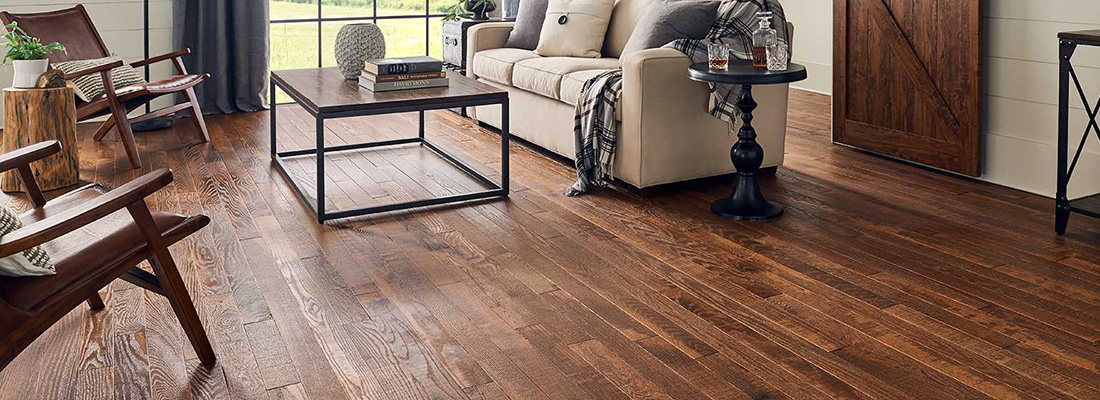
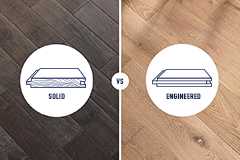 Solid vs Engineered Hardwood Flooring
Solid vs Engineered Hardwood Flooring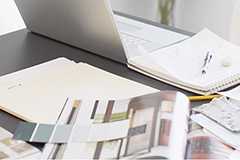 Guide To Choosing a Hardwood Floor
Guide To Choosing a Hardwood Floor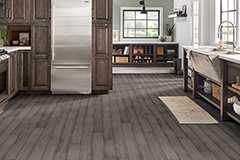 Hardwood Flooring Room Inspiration Guide
Hardwood Flooring Room Inspiration Guide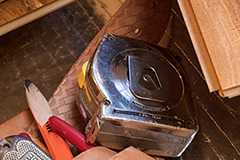 10 Things to Know About Hardwood Floor Installation
10 Things to Know About Hardwood Floor Installation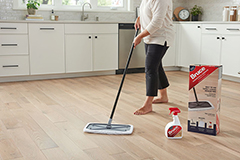 How To Clean and Protect Hardwood Flooring
How To Clean and Protect Hardwood Flooring